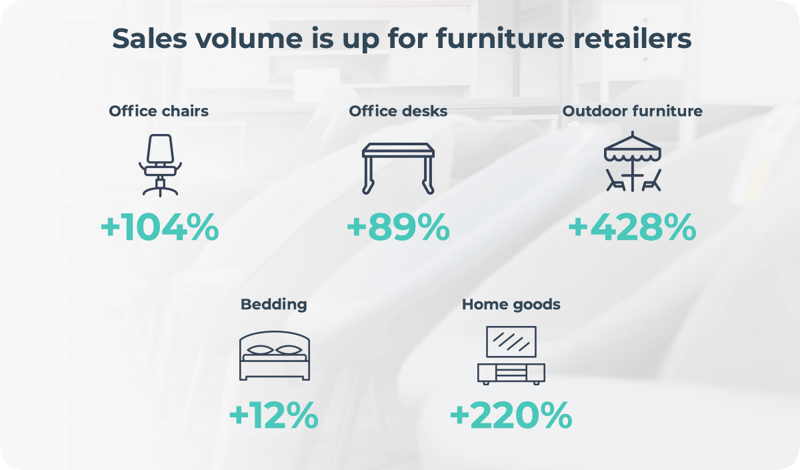Change is a constant in business. But when faced with exceptional events — like the COVID-19 outbreak — companies need to take a hard look at their tools, systems, processes, and strategies.
As furniture brands and retailers evaluate the best way to engage consumers in the new social distancing economy, key marketing tips include enhancing their online presence, focusing on e-commerce optimization, and building trust in preparation for the retail rebound.
With COVID-19 pushing consumers to shop online for their non-essential needs, furniture retailers will need to work even harder to step up their e-commerce game and get a share of the pie.
The impact of COVID-19 on furniture businesses
The global pandemic has catapulted e-commerce into hyper-drive. Consumer demand for online shopping has never been greater, and the companies that were well prepared for e-commerce before the outbreak, have a clear advantage.
According to Stackline, in March 2020 the online sales of office chairs increased by 104%, and desk sales also went up 89% when compared with the same period last year.
Office Designs has seen a huge increase in demand for products that make transitioning from working in a traditional office setting to working full-time from home easier, and much less painful. These products have been flying out of our warehouse, and we haven't seen the trend slow down. - Kate Kronenberg, eCommerce Merchandising Manager, Smart Furniture and Office Designs
Social distancing has made consumers think about how they can create an outdoor space that offers them the freedom and space to enjoy the warm weather in the coming months.
Data from Criteo shows that outdoor furniture sales went through the roof in the UK (+1908%), Germany (+956%), and also rose in the US (+428%), and France (+303%).
Besides outdoor furniture, home appliances, and bedding and linens have seen search increases along with a light conversions boost in each (+7% and +12%, respectively).
According to Bolt commerce, almost all of the platform’s sellers within the furniture category have seen revenue growth during the pandemic. When comparing their data from the first full week of March to the first full week of April, sales volume is up 220% on average for those retailers.

As reported by Furniture Today, online browsing for furniture increased by more than 200% in March during the COVID-19 pandemic. All of these stats confirm that you can sell any product online, and if you do it right, you will find many people who will buy it.
Depending on the maturity of your e-commerce journey, concentrate on proven strategies that work.
If you can review your historical performance, you should focus on initiatives or campaigns that work for you and yield the best results. Don’t forget you need the best team to support the surge in eCommerce sales. Many retailers already missed the boat as they may not be eCom ready, and companies that are ready for online sales are going to survive and thrive and reap the rewards in the future, as customer behavior will lean even more towards online shopping. - Ash Mehta, Head of E-commerce & Digital Strategy, Plush
Unfortunately, many furniture businesses that were delaying digital transformation efforts have been caught flat-footed, without the ability to deliver a positive digital experience.
The good news is that thanks to advanced technologies, the opportunity to build an improved digital experience has never been easier.
7 Tactics to help you step-up your furniture e-commerce game
Many furniture businesses are still trying to figure out the best way to increase conversions after a global shift in consumer behavior. If there is something we can learn from this situation, it is that it’s not enough for retailers to compete on products and services. In today’s unprecedented times, the biggest differentiator will be customer engagement.
Companies need to react fast. Responding to urgent needs and shifting behavior requires flexibility, adaptation, and the ability to adopt new initiatives that you can deploy in days or weeks—not months or years.
Today, we’re sharing 7 tactics that will help you take your e-commerce content optimization game to the next level.
1. Bridge the online-offline gap
For many consumers who had resisted online shopping, it has now become a necessity. Even though some consumers will go back to their routine for in-store shopping in the post-COVID world, many will retain their new online-shopping preferences.
Furniture companies must make efforts to close the online-offline gap and instill confidence in customers that are considering online shopping.
The Danish DTC brand, Sofacompany, uses creative customer experience tactics to ease the decision-making process for customers.
- Virtual consulting services: Customers can get advice and guidance on choosing the right sofa by using the online chat or reaching out to Sofacompny’s customer service by phone.
- Free fabrics: The best way to compensate for the lack of tactile sense for online shoppers is to offer them free fabrics. This way, they can get the “touch and feel” experience, which for many people might be the ultimate decision point. Since the coronavirus crisis, Sofacompany’s fabric sample orders have increased three times.

2. Rely on 3D product visualization
The essential asset you need to boost online furniture sales is a high-quality product visuals library. The fact is that, in most cases, your website is the first touchpoint that customers and business buyers have with your brand. A website is even more important now, during these unusual times when stores are closed and trade shows are postponed or canceled.
Back in the day, traditional photography was the favorite product visualization option for furniture companies. However, digital disruption has brought a more flexible and cost-effective alternative with better output quality. Today, a lot of companies have replaced traditional product photography with 3D visuals.
The coronavirus outbreak has pointed out several more inefficiencies and weaknesses in traditional product photography. Organizing a product photoshoot is very costly and almost impossible due to recent events.

Some of the main advantages tipping the balance in favor of 3D product visualization services include:
- Cost and time efficiency—3D product visualization is cheaper than photography if you have 1.5 variations per product. The bottom line is that for furniture companies with more variations per product, it makes more sense to use 3D product visualization instead of traditional photography.
- Logistics—Organizing a product photoshoot is challenging even in “normal” times. In times of uncertainty, it becomes almost impossible. Looking long-term, adopting CGI will give you stability and a predictable time frame, taking logistic issues out of the equation.
- Product customization—Customers crave personalized experiences, and 71% are willing to pay a premium price for it. Today, technology makes it easier to enable product customization and to offer a personalized experience to your customers straight from your product pages.
- Quality and realism—Today, some furniture companies use more than 75% CGI in their furniture catalogs, and the level of quality is so high that you aren’t able to recognize the difference between a rendering and an actual photograph.
- Image and asset flexibility—When using product photography, changing settings, details, and lighting after the photoshoot can be daunting. With 3D product visualization, revisions and corrections are easy, and you can reuse the visuals in countless use cases. At this point, 3D is the only product visualization technology that produces high-quality assets that can be leveraged across channels.
I think people (customers) get a real sense of security when shopping online, and they can look all around the product without just making a decision based on an image. Pictures are worth 1000 words for sure, but 3d and virtualized AR are worth 1000 pictures when it comes to large purchase decision-making in an e-tailer space. - Aaron Levine, VP of IT and Digital Commerce, EQ3
3. Build a flexible supply chain
The COVID-19 outbreak has exposed the vulnerabilities of many furniture companies, especially the ones that had a high dependence on China for materials or finished products. Likewise, after the situation escalated in Italy, where most high-end leathers come from, furniture brands and retailers were faced with a harsh reality: supply chain risk management is essential for furniture businesses.
For a long time, companies were focused on supply chain optimization to minimize costs. They were not aware that they were walking on thin ice. This approach has created a vulnerable supply chain and removed buffers and flexibility to absorb disruptions.
The question is: What can furniture brands do to mitigate the supply chain risk?
Here are some strategies that can help you build a flexible supply chain:
- Diversify your supply chains from a geographic perspective to reduce the supply-side risks from any one country or region
- Have multi-sourced key commodities or strategic components to reduce reliance on one supplier
- Consider inventory strategy to buffer against supply chain disruption.
With the rapid changes in supply chain and logistics with state and national shut-downs, it is important to keep your supply chain as flexible as possible. We have partnered with large shippers who are considered essential businesses, meaning we will be able to get office chairs to our customers as demand for home office furniture continues to grow. - Kate Kronenberg, eCommerce Merchandising Manager, Smart Furniture and Office Designs
4. Try before you buy—augmented reality
The new norm of social distancing presents enormous challenges for the furniture industry. No one expected that the retail apocalypse that everyone was talking about would happen due to a pandemic.
The good news is that technology today is so advanced that it makes everything a lot easier during these difficult times.
Customers can see how a new sofa would look in their apartment, in real-time and without any risk that they are paying for something that doesn’t fit. The possibility to “try before you buy” is very important, especially for big-ticket items. This way, customers can virtually “try-out” furniture, not worrying about bad decisions, which removes a huge weight from their shoulders before the big purchase.
Thanks to digital transformation and new technologies, online presence becomes vital for success.
Today, given the circumstances, using augmented reality to help customers visualize furniture in their own space, or bridge the gap between business buyers and showrooms, can be the wind in your sails that you needed, and help you get through these turbulent times. Not only that, but it can also help you adapt and prepare for the future. Don’t forget that customers that engage with AR are eight times more likely to convert than customers that choose not to engage with AR.
5. Have a lenient return policy
Forward-thinking brands are well aware of the importance of a customer-centric return policy. According to UPS, 68% of shoppers check a website’s return and exchange policy before making a purchase.
Having a lenient return policy during these difficult times can give customers peace of mind and increase the probability of conversion. Also, a flexible return policy shows that you are confident in the products you sell, which improves the overall impression of your brand.
It’s no surprise that big players like Amazon and Apple were among the first to extend their return policy.
When it comes to online furniture shopping, prolonging the return window will decrease customer anxiety, thus encouraging them to make an online purchase.
The DTC brand, Interior Define, offers a 60-day return policy, a 10-year warranty, and unlimited furniture delivery. For customers that are not ready for delivery, due to the new situation, they offer an opportunity to store orders, free of charge, until May 31.
6. Use social media to stay top of mind
During a crisis, the first thing that companies turn to is cutting costs. We’ve witnessed that a lot of businesses have already reduced their marketing budgets.
As a consequence, Facebook ad rates have dropped by 20%, as reported by The Wall Street Journal. The question is whether companies should take advantage of this situation by reaching more potential customers, or save that budget while heading into an uncertain economy.
Kantar estimates that brands that go dark to save costs will see a 39% reduction in brand awareness and a delay in recovery after COVID-19. This is not just a simple estimation with no basis. Data shows that 60% of the brands that went ‘dark’ during the 2008 economic downturn saw ‘brand use’ decrease 24% and ‘brand image’ decrease 28%.
On the other hand, the coronavirus outbreak has caused a 21% increase in social media usage.
Creative marketers know that they should be wherever their potential customers are, so naturally, they will be upping budgets to stay top of mind, engage with their customers, and grow their brand’s market share.
7. Get ready for B2B e-commerce
B2B furniture players were struggling with e-commerce way before the coronavirus outbreak. However, now that most of the furniture trade shows are canceled or postponed, and it’s almost impossible to fly to other parts of the world to sign deals, furniture brands are finally facing the reality that e-commerce is not just for B2C companies.
The challenge now is how to fast-track their move to enable B2B e-commerce.
If you are one of those B2B furniture businesses that are looking for ways to sell online, the good news is that there are shortcuts that can help you get there faster.
One of them is enabling a simple online form or a PDF export of a product selection that will offer an opportunity for your retailers to make purchases through your website.
What’s Next?
As the pandemic drags on, the one big question on everyone’s mind is: what comes next? There’s no doubt that stores will soon be reopening. However, furniture companies, while planning for the retail rebound, must be sensitive and patient with customers, and seek out ways to leverage the coronavirus fueled e-commerce boom.
There’s no doubt that the world as we know it has changed forever. It’s up to furniture brands and retailers to think ahead and adopt technologies and customer experience tactics that will future-proof their business.




